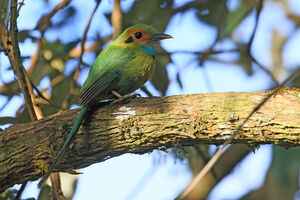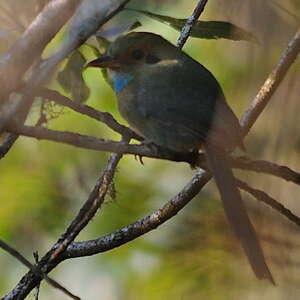Blue-throated Motmot
Aspatha gularis - Motmot à gorge bleue
Identification
Neotropical birds are colorful and often have puzzling names. French ornithologist Frederic de Lafresnaye (1783-1861) was credited with the discovery of the Blue-throated Motmot which he named Prionites gularis, translating to gorge qu'il faut voir. Richard Bowdler Sharpe, an English ornithologist (1847-1909) separated the Blue-throated Motmot into a genus which he named Aspatha, derived from the Greek word spathe meaning spoon or spatula; Aspatha meaning without a spatula, suggesting the lack of an eye-catching racket at the end of his tail. Aspatha gularis can be translated to the Motmot without a racket and with a remarkable throat. A small motmot, between 25-28 cm with a strong beak, slightly serrated, the upper mandible black contrasting with the light fawn lower mandible; lores and parotis dark brown-ochre, the auricular region marked by a large black mark. The Blue- throated Motmot is the only one not with a mask surrounding their eyes; the forehead and cap are darkly olive-green, the nape, also olive-green, with red glares whereas the mantle is of a lighter green, the remiges grey-green with rather dull coloring. The throat is a distinctive element of the Blue-throated Motmot, a magnificent, luminous, bleu-turquoise drawing attention; the chest and upper belly are of olive-green with red glares, below the throat a black point appears, sometimes divided in two similar drops. The chest is olive-green, the colour getting duller on the lower belly which is rather grey-blue. The tail is small, compared to other motmots, and presents no racket at the end; the outer rectrices are dark green almost grey while the central rectrices tend to a blue hue.The tarsi are pale brown. There is no dimorphism, the juveniles are predominately olive green and do not yet have the shine of the adults.
Subspecific information monotypic species
Foreign names
- Motmot à gorge bleue,
- Momoto gorjiazul,
- udu-de-papo-azul,
- Blaukehlmotmot,
- kéktorkú motmot,
- Blauwkeelmotmot,
- Motmot golazzurra,
- blåstrupig motmot,
- Blåstrupemotmot,
- momot modrohrdlý,
- momot modrohrdlý,
- Blåstrubet Motmot,
- sinikurkkumomotti,
- motmot golablau,
- piłodziób niebieskogardły,
- modrogrli motmot,
- Синегорлый момот,
- アオノドハチクイモドキ,
- 蓝喉翠鴗,
- blåstrupig motmot,
- 藍喉翠鴗,
Voice song and call
The Blue-throated Motmot gives out a hoot or huuk which can be spaced 5 to 10 seconds apart, but can also speed up its trill to transform it into a tyrolienne: hoodloodloodloodl or uudauudauuda, with the male and female calling back and forth. Its alarm call is a staccato and quite high hiii-hiii-hiii, giving the bird a feeling of gritting its teeth.
Habitat
Many Motmots remain at relatively low altitudes, but our Blue-throated Motmot can ascend from 1,300 m to 3,000 m, seeking out wet or semi-humid evergreen forests as well as pine forests.
Behaviour character trait
The Blue-throated Motmot is a sedentary bird, staying close to its nest or burrow. Some altitude movements have been observed, but they can only be assumed to be related to hunting for food.
Dietfeeding habits
The Blue-throated Motmot is mainly insectivorous, liking beetles and various larvae, though it frequently varies its menu with fruits and seeds. If it feeds its young mostly with insects, remains of fruits and seeds have been found in a burrow, suggesting that it is providing a balanced diet to its offspring!
Reproduction nesting
In April, Blue-throated Motmots brood in Guatemala and Mexico and juveniles begin to fly by the end of May. Their nest is actually a burrow measuring 1.40 to 1.80 metres long dug near a water source or stream; the access tunnel can have 90-degree angles leading to an oval-shaped chamber that is very low. The incubation of 2 to 3 eggs takes 21 to 22 days, with both parents taking turns in the burrow which they will have previously lined with feathers. After 29 to 31 days, the fledglings will take to the skies.
Geographic range
Threats - protection
IUCN conservation status
concern
in the Wild
threatened
evaluated
LC: The Blue-throated Motmot is confined to the northern part of Central America and the south of Mexico. Very discreet, with mostly nocturnal habits, its vocalizations are usually audible at dusk. We don't know much about it, its discretion is surely its best protection!
Sources of information
- IOC World Bird List (v15.1), Gill, F and D Donsker (Eds). 2025-12-07.
- Vol. 6 - Handbook of the Birds of the World, Josep del Hoyo-Andrew Elliott-Jordi Sargatal
- Scientific Birds Names, James A.Jobling
- xeno-canto, Sharing bird sounds from around the world,
- Avibase, Lepage Denis
- BirdLife International, BirdLife International
- The internet Bird Collection,
- Wikipédia, Wikipedia, The Free Encyclopedia
- HBW Alive,
Other sources of interest
 Specification sheet created on
02/08/2023 by Anne et Gabriel Leboff
Specification sheet created on
02/08/2023 by Anne et Gabriel LeboffTranslation by AI Oiseaux.net
© 1996-2025 Oiseaux.net
- Accipitriformes
- Aegotheliformes
- Anseriformes
- Apodiformes
- Apterygiformes
- Bucerotiformes
- Caprimulgiformes
- Cariamiformes
- Casuariiformes
- Charadriiformes
- Ciconiiformes
- Coliiformes
- Columbiformes
- Coraciiformes
- Cuculiformes
- Eurypygiformes
- Falconiformes
- Galliformes
- Gaviiformes
- Gruiformes
- Leptosomiformes
- Mesitornithiformes
- Musophagiformes
- Nyctibiiformes
- Opisthocomiformes
- Otidiformes
- Passeriformes
- Pelecaniformes
- Phaethontiformes
- Phoenicopteriformes
- Piciformes
- Podargiformes
- Podicipediformes
- Procellariiformes
- Psittaciformes
- Pterocliformes
- Rheiformes
- Sphenisciformes
- Steatornithiformes
- Strigiformes
- Struthioniformes
- Suliformes
- Tinamiformes
- Trogoniformes




